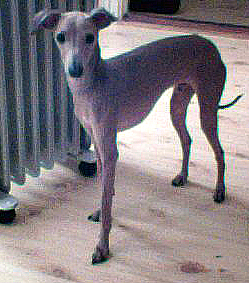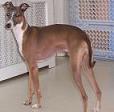
|
From Wikipedia the free encyclopedia, by MultiMedia |
| Italian Greyhound | ||
|---|---|---|

Eros.jpg
|
||
| Alternative names | ||
| Piccolo Levriero Italiano | ||
| Country of origin | ||
| Italy | ||
| Common nicknames | ||
| Classification and breed standards | ||
| FCI: | Group 10 Section 3 #200 | |
| AKC: | Toy | |
| ANKC: | Group 1 (Toys) | |
| CKC: | Group 5 - Toys | |
| KC (UK): | Toy | |
| NZKC: | Toy | |
| UKC: | Companion Breeds | |
| Not recognized by any major kennel club | ||
| This breed of Dog is extinct | ||
| Notes | ||
The Italian Greyhound is a small breed of Dog, specifically a member of the sight hound family and member of the toy group.

The Italian Greyhound is the smallest of the sight hounds, typically weighing 3 to 5 kg. They look like miniature Greyhounds.
The colour of the coat is a subject of much discussion. In England, the USA, and Australia, white spotted Italians are accepted, while the FCI standards adhered to in Europe allows white spots only on the chest and paws.
The modern Italian Greyhound's appearance is a result of breeders throughout Europe, particularly Austrian, German, Italian, and French breeders, making great contributions to the forming of this breed. The Italian Greyhound should resemble a small Greyhound, or rather a Sloughi. It is important that the Dogs are significantly more elegant and graceful than these breeds, though.
The Italian Greyhound is considered a good companion Dog, as they are very affectionate.
The Italian Greyhound's apparent lack of wide appeal is possibly because of their fragile appearance, with their spindly legs. The reality of the breed is quite contrary to the appearance, though, as they are frequently described as a 'big' Dog in a small package. They also have a realatively loud bark. In fact, the breed will be equally at home in a city and in the country, and it does not require as much exercise as larger breeds. The Italian Greyhound is hardy, rarely ill, intelligent and easy to teach.
Sometimes, IG's will make a resonably good guard-Dog and bark at things that aren't usually in the street. They may also bark at passers by.
IG's often get along with cats so if you already have a cat and you are looking for a suitable Dog which won't chase your beloved kitty all day long, IG's can be recommended.
IG's despise the wind, wet and cold and will sometimes refuse to do their " business " outside if it is raining so some recommend having some old newspaper on the floor near the exit.
This breed, like most Dogs, is not a fussy eater and will eat almost anything, including the month-old scraps from your garden. Most will eat enthusiastically, but some get more picky about their food as they age.
IGs are good with kids but their thin bones are fragile and can be hurt by rough play from young children.
Dogs of this breed have an almost odour-free, easily managed coat. Although the coat is incredibly short, it can shed. The breed simply loves the company of people, and will promptly occupy your lap if you let it. In fact, many owners of this breed have them sleeping with them in their beds.
The young Dog will often be particularly active, and this high level of activity sometimes lead them to try to 'fly' from furniture or stairs. It is important to keep a close eye on the Dogs in this initial phase as their young bones are still fragile. The first year of life is the most accident-prone, although the graceful legs often seem to withstand incredible punishment they are not invulnerable.
IGs love to run as fast as they possibly can, and, like all Dogs, it's important that they have an opportunity to run full out at least once daily, either in the back yard or under supervision and control in a larger area. Like most Dogs they enjoy digging and, if left to their own devices for entertainment and exercise, might resort to digging or other destructive behavior.
Like most smaller breeds, the Italian Greyhound can be difficult to housebreak. This will normally come along with patience and training, but at a slower pace than most other breeds. Patience is the only way to help the training along, and remember that the breed is small and as such the Dog will have a small bladder.
Members of this breed might love the sunlight, so owners need to ensure that they don't become overheated, and they do get sunburned (particularly on their heads and bellies), so it's recommended to use sunscreen on them.
The breed is relatively free of disease, but the following ailments do occur:
The name of the breed is a reference to the breed's popularity in renaissance Italy. Mummified Dogs very similar to the Italian Greyhound (or small Greyhounds) have been found in Egypt, and pictorials of small Greyhounds have been found in Pompeii, and they were probably the only accepted companion-Dog there. As an amusing aside the expression 'Cave Canem' (Beware of the Dog) was a warning to visitors, not that the Dogs would attack but to beware of damaging the small Dogs.
Although the small Dogs are mainly companionship Dogs they have in fact been used for hunting purposes, often in combination with hunting falcons.
The grace of the breed has prompted several artists to include the Dogs in paintings, among others Velasquez, Pisanello and Giotto. The breed has been popular with royalty throughout, among the best known royal aficionados were Mary Stuart, Queen Anne, Queen Victoria, Catherine The Great, Frederick the Great and the Norwegian Queen Maud.
Some Italian Greyhounds enjoy Dog agility. The breed's lithe body and its love of action enable it to potentially do well at this sport, although not many IGs participate and their natural inclination is for straight-out racing rather than for working tightly as a team with a handler on a technical course.
Lure coursing is another activity well-fitted to the Italian Greyhound, and they seem to enjoy it tremendously. Although the Italian Greyhound is a very fast Dog, it is not as well suited to racing as its larger cousin.
Dogs, made by MultiMedia | Free content and software
This guide is licensed under the GNU Free Documentation License. It uses material from the Wikipedia.